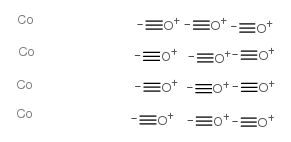17786-31-1
| Name | carbon monoxide,cobalt |
|---|---|
| Synonyms |
Tetracobaltdodecacarbonyl
Dodecacarbonyltetracobalt Cobaltcarbonyl (Co4(CO)12) (6CI) Tetracobalt dedecacarbonyl EINECS 241-763-1 MFCD00064698 Dodecacarbonyltetracobalt min Cobalt,tri-m-carbonylnonacarbonyltetra-,tetrahedro-(8CI) |
| Density | 2.09 |
|---|---|
| Melting Point | 60ºC (dec.) |
| Molecular Formula | C12Co4O12 |
| Molecular Weight | 571.85400 |
| Exact Mass | 571.67200 |
|
Section 1: Product Identification Chemical Name:Tetracobalt dodecacarbonyl, min. 98% CAS Registry Number:17786-31-1 Formula:Co4(CO)12 EINECS Number:none Chemical Family:metal carbonyl complexes Synonym:Dodecacarbonyl tetracobalt
Section 2: Composition and Information on Ingredients IngredientCAS NumberPercentACGIH (TWA)OSHA (PEL) Title Compound17786-31-1100%0.02mg/m3no data Section 3: Hazards Identification Vapor may be harmful. Inhalation may lead to headaches and dizziness. Limited evidence of a carcinogenic Emergency Overview: effect. Primary Routes of Exposure:Ingestion, inhalation Eye Contact:May cause mild irritation to the eyes. Skin Contact:May cause mild irritation to the skin. Inhalation:Inhalation could lead to dizziness and headache. Ingestion:No information available on the effects from ingestion. Acute Health Affects:Inhalation could lead to headache and dizziness. Chronic Health Affects:Cobalt is a suspected carcinogen of the lungs and connective tissue. NTP:No IARC:Yes OSHA:No SECTION 4: First Aid Measures Immediately flush the eyes with copious amounts of water for at least 15 minutes. A victim will need Eye Exposure: assistance in keeping their eye lids open. Get immediate medical attention. Wash the affected area immediately with water. Remove contaminated clothing if necessary. Seek medical Skin Exposure: assistance if irritation persists. Remove victim to fresh air immediately. Keep the victim lying down and warm. Give oxygen as soon as Inhalation: possible. If shock occurs, respond with appropriate first aid. Transport the victim to a hospital. Seek medical attention immediately. Keep the victim calm. Give water to dilute the toxin (only if conscious). Ingestion: Induce vomiting only if directed by medical personnel. SECTION 5: Fire Fighting Measures Flash Point:not applicable Autoignition Temperature:no data Explosion Limits:no data Extinguishing Medium:carbon dioxide, dry chemical or foam If involved in a fire, fire fighters should be equipped with a NIOSH-approved positive pressure self-contained Special Fire Fighting Procedures: breathing apparatus. Hazardous Combustion andcarbon monoxide, carbon dioxide, and cobalt oxide dust. Decomposion Products: Unusual Fire or Explosion Hazards: Flammable solid. No unusual fire or explosion hazards. SECTION 6: Accidental Release Measures Spill and Leak Procedures:Small quantities can be mixed with sodium carbonate or vermiculite and swept up. SECTION 7: Handling and Storage Handling and Storage:Store in a cool, dry, well-ventilated area away from heat and direct sunlight. Keep containers tightly sealed. SECTION 8: Exposure Controls and Personal Protection Eye Protection:Always wear approved safety glasses when handling chemical substances. Skin Protection:Wear protective clothing and gloves. Consult with glove manufacturer to determine the proper type of glove. Ventilation:This product should be handled in an efficient fume hood. If ventilation is not available a respirator should be worn. The use of respirators requires a Respirator Respirator: Protection Program to be in compliance 29 CFR 1910.134. Ventilation:This product should be handled in an efficient fume hood. Additional Protection:No additional protection required. SECTION 9: Physical and Chemical Properties Color and Form:black xtl. Molecular Weight:571.85 Melting Point:60° dec. Boiling Point:no data Vapor Pressure:no data Specific Gravity:2.09 Odor:none Solubility in Water:Insoluble SECTION 10: Stability and Reactivity Stability:air sensitive, (store cold) Hazardous Polymerization:no hazardous polymerization Conditions to Avoid:prolonged exposure to air. Incompatibility:Oxidizing agents and halogens Decomposition Products:carbon dioxide, carbon monoxide, cobalt oxide SECTION 11: Toxicological Information RTECS Data:No specific information available on this product. Carcinogenic Effects:No data available Mutagenic Effects:No data available Tetratogenic Effects:No data available SECTION 12: Ecological Information Ecological Information:No information available. SECTION 13: Disposal Considerations Disposal:Dispose of this material according to local, state and federal regulations. SECTION 14: Transportation Shipping Name (CFR):Flammable solids, inorganic, N.O.S. Hazard Class (CFR):4.1 Additional Hazard Class (CFR):NA Packaging Group (CFR):II UN ID Number (CFR):UN# 3178 Shipping Name (IATA):Flammable solid, inorganic, N.O.S. Hazard Class (IATA):4.1 Additional Hazard Class (IATA):NA Packaging Group (IATA):II UN ID Number (IATA):UN# 3178 SECTION 15: Regulatory Information TSCA:Not listed in the TSCA inventory. SARA (Title 313):Title compound: See Category Code N096 for reporting. Second Ingredient:none SECTION 16 - ADDITIONAL INFORMATION N/A |
CHEMICAL IDENTIFICATION
|
| Hazard Codes | T+ |
|---|---|
| Risk Phrases | R23/24/25 |
| Safety Phrases | S23;S36/S37 |
| RIDADR | UN 3466 |
| Packaging Group | II |
| Hazard Class | 6.1 |
